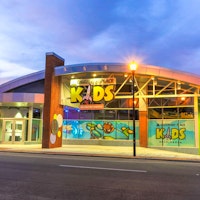How do you bring math into your visit at the Museum?
Discovery Place Kids Huntersville
Incorporating a little math into your visit to Discovery Place Kids-Huntersville is as easy as 1, 2, 3. Here are some tips to get you started:
Sort it out

A great activity that can be adjusted to fit your child’s age and skill level is sorting.
Sorting is one of the most prolific math skills a child needs to develop, and lucky for you, it’s one of the easiest to replicate in the Museum.
“Rules are everywhere in math,” says Stevie Galicia, Program Specialist at the Museum. “Dictating how items are sorted helps children begin to understand how rules are present in math, and not just something that we use socially (like rules their parents have for them).”
Start by having your child sort by color, size and shape.
Sorting things into ‘similar’ and ‘different’ categories helps children recognize patterns, which is imperative to algebra skills.
Sit with your child and identify a group of various objects and place them into piles based on a single attribute. Remember, sorting is about understanding relationships between “like” objects.
When classifying objects also ask your child to identify the attribute. For example, you may have sorted a pile of red objects, but you take it one step further and classify them by shape.
Great Places to Sort in the Museum:
- Town Market: Sort grocery items as you put in the cart or create a pattern to replicate with the products.
- Café: Place all the items in the correct area or order a meal that requires sorting into patterns.
- Vet’s Office: Categorize and classify the animals.
We think you're numero uno

Enumeration – what is it and why is important? You’re working on enumeration every time you ask your child ‘how many?’
Counting helps kids make the correlation between saying the number and how many physical objects are present.
“In order to perform math functions, kids need to know their numbers and their values first,” Stevie says.
Finding ways to count at the Museum is also a great way to accommodate different types of learners. For example, when working on addition and subtraction, having different objects either added or taken away helps visual learners make the verbal connection.
Great Places to Count in the Museum:
- Brick Factory: ask your child to count the number of bricks as they are playing with them or as they fall from the factory.
- Farm: Play with your child by adding, subtracting and counting the eggs in the chicken coop. You can also count the number of apples that fall off the tree.
- Town Market: As your child picks up items to place in the cart, ask your little shopper to count them cumulatively.
Get into shape(s)

The Museum is a great place to get your geometry skills in shape.
“Shape recognition and categorizing is important to geometry skills,” Stevie says. “As your child begins to recognize shapes, they will also become better at identifying the differences in numbers and letters.”
Shape recognition also helps with writing skills – by tracing and drawing shapes your child is improving penmanship without even knowing it.
Great Places to Work on Shapes in the Museum:
- Everywhere: Go on a shape-finding scavenger hunt. Pick a shape and search the entire Museum for how many times you can find it (and remember to count them cumulatively).
- Second level: Sit among the blocks and name the shapes as you build.
Special programming in December
Throughout December, the Museum is focusing specifically on math (with a holiday twist, of course). Check out the special stations including snowball counting, cooking with math, shape sorting, number hunting, tree matching, giant tangrams, object sorting and more.
And, don’t forget you can ask a staff member any time about other math-based demonstrations, especially if you want to work on something specific with your child.




